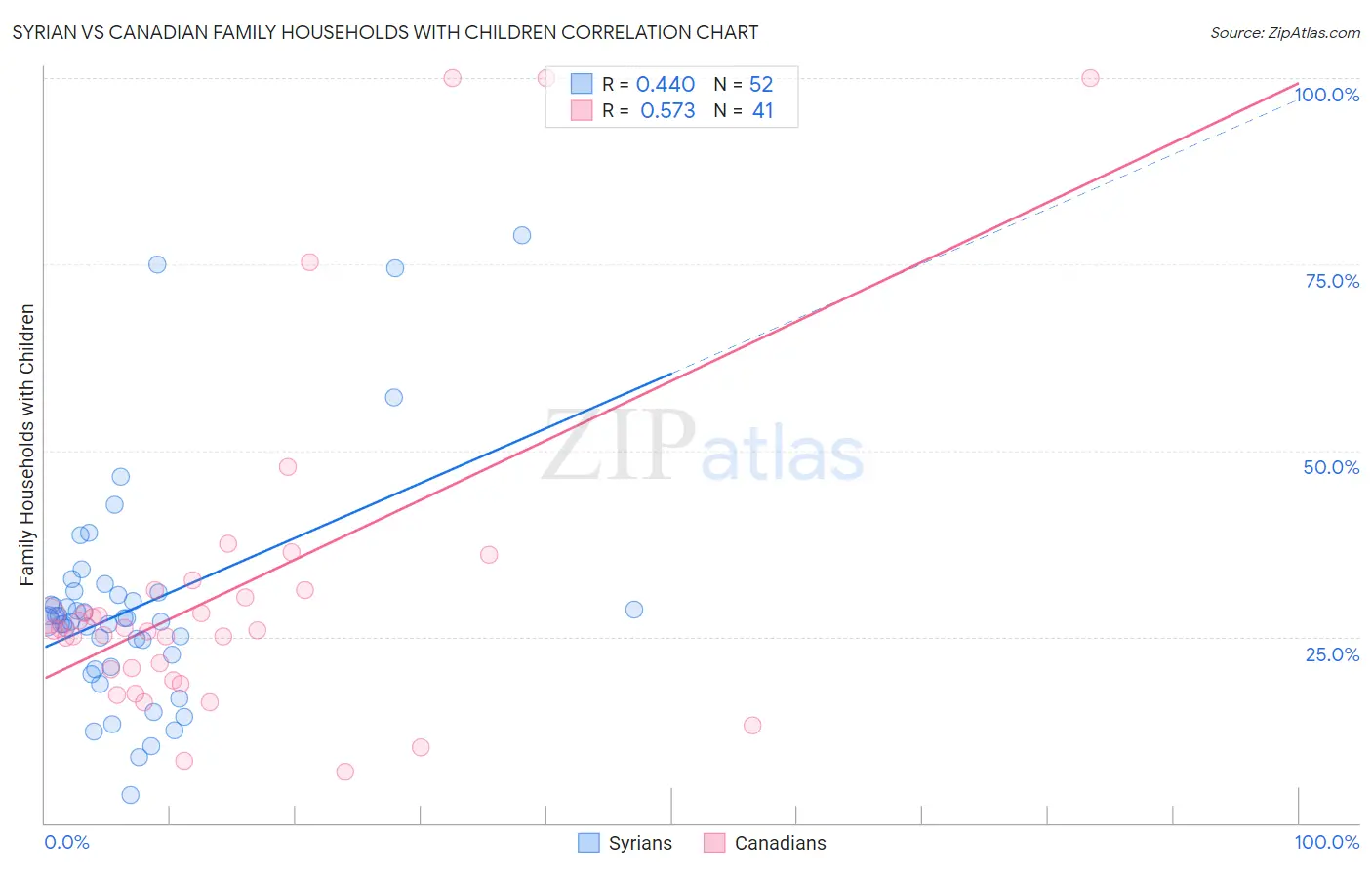Syrian vs Canadian Family Households with Children
COMPARE
Syrian
Canadian
Family Households with Children
Family Households with Children Comparison
Syrians
Canadians
27.8%
FAMILY HOUSEHOLDS WITH CHILDREN
89.7/ 100
METRIC RATING
128th/ 347
METRIC RANK
27.1%
FAMILY HOUSEHOLDS WITH CHILDREN
7.5/ 100
METRIC RATING
225th/ 347
METRIC RANK
Syrian vs Canadian Family Households with Children Correlation Chart
The statistical analysis conducted on geographies consisting of 266,095,178 people shows a moderate positive correlation between the proportion of Syrians and percentage of family households with children in the United States with a correlation coefficient (R) of 0.440 and weighted average of 27.8%. Similarly, the statistical analysis conducted on geographies consisting of 437,085,688 people shows a substantial positive correlation between the proportion of Canadians and percentage of family households with children in the United States with a correlation coefficient (R) of 0.573 and weighted average of 27.1%, a difference of 2.6%.

Family Households with Children Correlation Summary
| Measurement | Syrian | Canadian |
| Minimum | 3.8% | 6.9% |
| Maximum | 78.9% | 100.0% |
| Range | 75.1% | 93.1% |
| Mean | 29.0% | 31.4% |
| Median | 27.2% | 26.0% |
| Interquartile 25% (IQ1) | 21.8% | 19.9% |
| Interquartile 75% (IQ3) | 30.8% | 31.3% |
| Interquartile Range (IQR) | 8.9% | 11.4% |
| Standard Deviation (Sample) | 15.0% | 22.5% |
| Standard Deviation (Population) | 14.8% | 22.2% |
Similar Demographics by Family Households with Children
Demographics Similar to Syrians by Family Households with Children
In terms of family households with children, the demographic groups most similar to Syrians are Belizean (27.8%, a difference of 0.020%), Immigrants from Eritrea (27.8%, a difference of 0.020%), Immigrants from Ethiopia (27.8%, a difference of 0.050%), Immigrants from Singapore (27.8%, a difference of 0.070%), and Ecuadorian (27.8%, a difference of 0.070%).
| Demographics | Rating | Rank | Family Households with Children |
| Immigrants | Western Asia | 93.6 /100 | #121 | Exceptional 27.9% |
| Immigrants | Zimbabwe | 92.8 /100 | #122 | Exceptional 27.8% |
| Immigrants | Northern Africa | 91.8 /100 | #123 | Exceptional 27.8% |
| Immigrants | Singapore | 90.8 /100 | #124 | Exceptional 27.8% |
| Ecuadorians | 90.8 /100 | #125 | Exceptional 27.8% |
| Immigrants | Ethiopia | 90.5 /100 | #126 | Exceptional 27.8% |
| Belizeans | 90.0 /100 | #127 | Exceptional 27.8% |
| Syrians | 89.7 /100 | #128 | Excellent 27.8% |
| Immigrants | Eritrea | 89.4 /100 | #129 | Excellent 27.8% |
| Cajuns | 87.6 /100 | #130 | Excellent 27.7% |
| Lebanese | 87.4 /100 | #131 | Excellent 27.7% |
| Immigrants | Belize | 85.7 /100 | #132 | Excellent 27.7% |
| Iranians | 85.2 /100 | #133 | Excellent 27.7% |
| Immigrants | Panama | 84.9 /100 | #134 | Excellent 27.7% |
| Immigrants | Ecuador | 84.6 /100 | #135 | Excellent 27.7% |
Demographics Similar to Canadians by Family Households with Children
In terms of family households with children, the demographic groups most similar to Canadians are Czechoslovakian (27.0%, a difference of 0.080%), Tsimshian (27.0%, a difference of 0.080%), Scottish (27.0%, a difference of 0.080%), German (27.1%, a difference of 0.090%), and Immigrants from Caribbean (27.0%, a difference of 0.11%).
| Demographics | Rating | Rank | Family Households with Children |
| Greeks | 11.4 /100 | #218 | Poor 27.1% |
| Immigrants | Japan | 10.7 /100 | #219 | Poor 27.1% |
| Austrians | 9.9 /100 | #220 | Tragic 27.1% |
| New Zealanders | 9.6 /100 | #221 | Tragic 27.1% |
| Paraguayans | 9.4 /100 | #222 | Tragic 27.1% |
| Pima | 9.2 /100 | #223 | Tragic 27.1% |
| Germans | 8.7 /100 | #224 | Tragic 27.1% |
| Canadians | 7.5 /100 | #225 | Tragic 27.1% |
| Czechoslovakians | 6.6 /100 | #226 | Tragic 27.0% |
| Tsimshian | 6.6 /100 | #227 | Tragic 27.0% |
| Scottish | 6.5 /100 | #228 | Tragic 27.0% |
| Immigrants | Caribbean | 6.3 /100 | #229 | Tragic 27.0% |
| Bulgarians | 5.8 /100 | #230 | Tragic 27.0% |
| Luxembourgers | 5.5 /100 | #231 | Tragic 27.0% |
| Yugoslavians | 5.1 /100 | #232 | Tragic 27.0% |